#antye greie
Text

AGF, poemproducer, (digital album), 2023
All music recorded, performed, produced, mixed & mastered by AGF, except fieldWORK which features #sonicwilderness / the nusasonic crew from a feminist sound camp in 2018 Asa Rahmana, Ayu Saraswati, Joee and I, Menstrual Synthdrone, Sarana, Alyana Cabral, Utami Atasia Ishii, Abiyya Ladangku
The cover image is derived from a photo taken by Antye [Greie-Ripatti] of her local friend Tiina Laurila on a common walk and rest on the frozen sea early 2023 in nearby bay and her glitch-like visual generation, she has performed with Vladislav Delay in recent years
#graphic design#art#music#music album#cover#agf#poemproducer#antye greie#antye greie ripatti#agf producktion#sonicwilderness#nusasonic#tiina laurila#vladislav delay#sasu ripatti#2020s
53 notes
·
View notes
Text
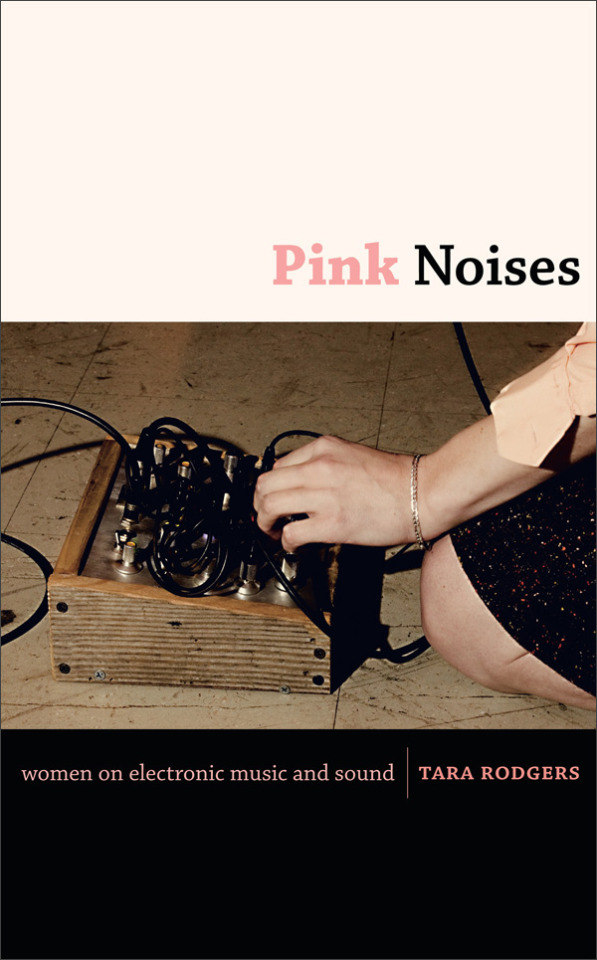
Pink Noises: Women on Electronic Music and Sound by Tara Rodgers
Get it from my Google Drive HERE
Pink Noises brings together twenty-four interviews with women in electronic music and sound cultures, including club and radio DJs, remixers, composers, improvisers, instrument builders, and installation and performance artists. The collection is an extension of Pinknoises.com, the critically-acclaimed website founded by musician and scholar Tara Rodgers in 2000 to promote women in electronic music and make information about music production more accessible to women and girls. That site featured interviews that Rodgers conducted with women artists, exploring their personal histories, their creative methods, and the roles of gender in their work. This book offers new and lengthier interviews, a critical introduction, and resources for further research and technological engagement.
Contemporary electronic music practices are illuminated through the stories of women artists of different generations and cultural backgrounds. They include the creators of ambient soundscapes, “performance novels,” sound sculptures, and custom software, as well as the developer of the Deep Listening philosophy and the founders of the Liquid Sound Lounge radio show and the monthly Basement Bhangra parties in New York. These and many other artists open up about topics such as their conflicted relationships to formal music training and mainstream media representations of women in electronic music. They discuss using sound to work creatively with structures of time and space, and voice and language; challenge distinctions of nature and culture; question norms of technological practice; and balance their needs for productive solitude with collaboration and community. Whether designing and building modular synthesizers with analog circuits or performing with a wearable apparatus that translates muscle movements into electronic sound, these artists expand notions of who and what counts in matters of invention, production, and noisemaking. Pink Noises is a powerful testimony to the presence and vitality of women in electronic music cultures, and to the relevance of sound to feminist concerns.
Interviewees: Maria Chavez, Beth Coleman (M. Singe), Antye Greie (AGF), Jeannie Hopper, Bevin Kelley (Blevin Blectum), Christina Kubisch, Le Tigre, Annea Lockwood, Giulia Loli (DJ Mutamassik), Rekha Malhotra (DJ Rekha), Riz Maslen (Neotropic), Kaffe Matthews, Susan Morabito, Ikue Mori, Pauline Oliveros, Pamela Z, Chantal Passamonte (Mira Calix), Maggi Payne, Eliane Radigue, Jessica Rylan, Carla Scaletti, Laetitia Sonami, Bev Stanton (Arthur Loves Plastic), Keiko Uenishi (o.blaat)
#book#tara rodgers#annea lockwood#pamela z#le tigre#ikue mori#Pauline Oliveros#Pink Noises: Women on Electronic Music and Sound
396 notes
·
View notes
Text
Music stream for Gaza !
All donations raised from this compilation will be sent to Medical Aids for Palestine (MAP), an organization prioritizing the health of Palestinians living under occupation and as refugees. They provide immediate medical aid to those in need and work to develop local capacity and skills for the long-term development of the Palestinian healthcare system.
6 notes
·
View notes
Text
all the rules are there to be broken 💁 melody and rhythm? 👀 are they really necessary 🧐
3 notes
·
View notes
Photo

cet été deux personnes très différentes m’ont dit de publier mes journaux et cette troisième personne ci-dessus (la musicienne antye greie) me conforte dans mon envie
3 notes
·
View notes
Photo
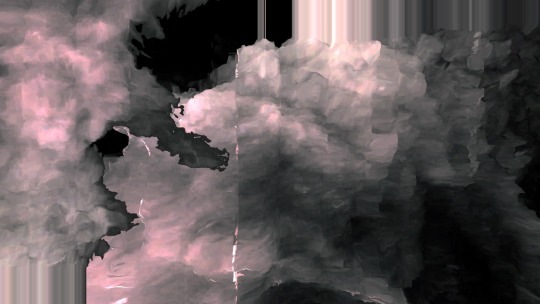
🔴 ON AIR - Today Tuesday 6 June 2023 at 7:00 pm (CEST) - usmaradio.org
USMA for Radioart106
#𝟭𝟱𝟳_𝗥𝗘𝗖𝗢𝗡 𝘄𝗶𝘁𝗵 𝗔𝗚𝗙 [58 min]
methodologies of sounding. REC:on ⇢ a space {inflection} for political sound work & political listening ↣ derived from a compositional technology of ⥉ growing sound ⤹ growing connections ‡ ⁜ ⁂ ⁁ ※ growing networks ✸ #soundasgrowing - the piece explores, the listening space rec-on.org, sound and listening, critic and reflects sound practice. Listen to the current world and identify space for artistic positioning. What is political sound? What is collective sound? Does sound have a transformative quality? What is a sonic position?
Antye Greie-Ripatti AGF is an audio sculptress, composer and sound artist. Curator, facilitator of sound art, poemproducer & intersectional feminist networker. Her work emphasises language, sound, listening, voice and politics and can be summarised as Feminist Sonic Technologies expressed in mixed media, audiovisual live performances, digital communication, sound installations, commissions for radio, movies, theatres and online. In 2020 she founded RECon (rec-on.org) – a sound & listening exhibition space for political sound and the sound-activist community around it.
>> Radioart106 explores radiophonic works of worldwide radio artists. Radio art is a subset of Sound art where radio art is produced for the medium of radio and is specifically intended for broadcast. A new radio work is aired every first (or second) Tuesday of the month at 7:00 pm CET on usmaradio.org
0 notes
Photo
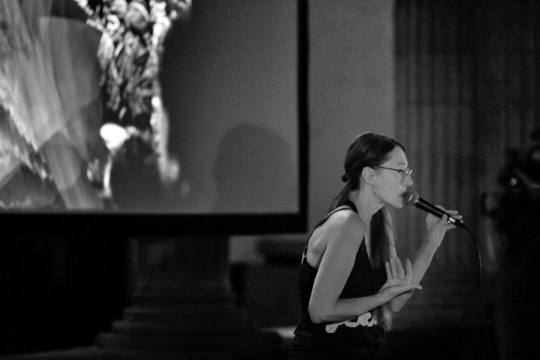
In this podcast, we talk to Antye Greie about language, sound, and the body. At their intersection, the voice emerges, with its multiple resonances and different ways of introducing the voice of others through her own practice and space of visibility. Along the way, we look at her work and methodology, from the deconstruction of texts to the implementation of what she calls “feminist sonic technologies”. Permeating everything, we encounter the memory and the experience of having been raised in the values and the political experiment of the former Eastern Bloc and feeling part of a silenced diaspora.
https://rwm.macba.cat/en/sonia/sonia-366-antye-greie-agf
Music: AGF. Recorded: February 2022.
1 note
·
View note
Photo
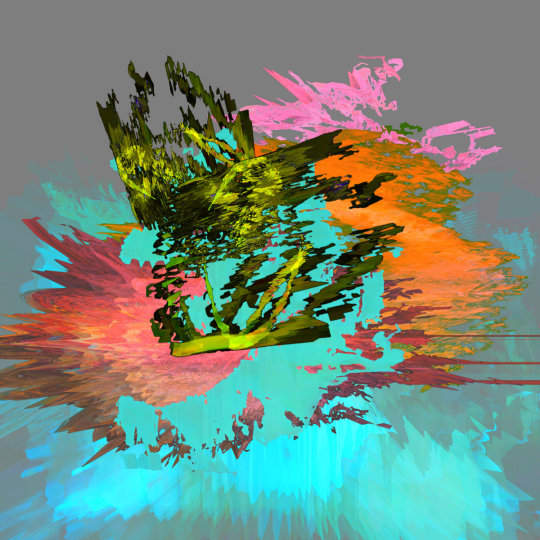
uttu EP by AGF
AGF - uttu EP
Huge, powerful, goddess-summoning anti-beats from Finnish sound artist Antye Greie-Ripatti. Fierce, abstract sound design otherworlds you’ve got to hear.
-Kris
1 note
·
View note
Text
Week 6 notes sound art 1
Week 6 Sound Arts introduction lecture notes:
Today we looked at Sound art in terms of field recording, practices and acoustic ecology and soundscapes. Francisco Lopez. As described in his bio on his website:
“Francisco López is internationally recognized as one of the major figures of the sound art and experimental music scene. For almost forty years he has developed an astonishing sonic universe, absolutely personal and iconoclastic, based on a profound listening of the world. Destroying boundaries between industrial sounds and wilderness sound environments, shifting with passion from the limits of perception to the most dreadful abyss of sonic power, proposing a blind, profound and transcendental listening, freed from the imperatives of knowledge and open to sensory and spiritual expansion”.
We were signposted to a book to learn context, sound artist experiences and routes within soundscape studies and acoustic ecology and field recording look at book below the authors describe sound art as:
“A diverse range of practices which explore and investigate aspects of the lived environment from microscopic to the panoramic, through the medium of recorded sound.
(Lane, C., & Carlyle, A. 2013. In the Field: The Art of Field Recording.)
This book contains 18 interviews with artists who use field recording as the core of their practice: Andrea Polli, Annea Lockwood, Antye Greie, Budhaditya Chattopadhyay, Christina Kubisch, Davide Tidoni, Felicity Ford, Francisco Lopez, Hildegard Westerkamp, Hiroki Sasajima, Ian Rawes, Jana Winderen, Jez Riley French, Lasse-Marc Riek, Manuela Barile, Peter Cusack, Steven Feld and Viv Corringham.
Field recording can be called phonography sound writing.
“
The science or practice of transcribing speech by means of symbols representing elements of sound; phonetic transcription.
A system of shorthand based on phonetic transcription.
The science of sound-signs, or the representation of vocal sounds.”
(https://www.wordnik.com/words/phonography)
Putting something else into space or the landscape, interdisciplinary: anthropology, social sciences, oral histories, geography cross disciplinary route.
Field recording comes out of ethnomusicology
“ Ethnomusicology is the study of music in its social and cultural contexts. Ethnomusicologists examine music as a social process in order to understand not only what music is but what it means to its practitioners and audiences.”
https://www.ethnomusicology.org/page/AboutEthnomusicol
“Ethnomusicologists believe that all humans, not just those we call musicians, are musical, and that musicality is one of the essential touchstones of the human experience. This insight raises big questions about the nature of music and the nature of humankind, and ethnomusicologists argue that to properly address these questions, we must study music in all its geographical and historical diversity. “
Rice, T. (2014). Ethnomusicology: A Very Short Introduction. United Kingdom.
In terms of origin points Joefri bruyninckx.
Capturing voices.
bureau of Ethnomusicology – in The US took over this institution tied into the eradication of indigenous people – white saviour recordists- recording the violence they were already implicit in.
About the BAE
Internet resources
Our holdings
No electricity – in the field what does this term mean, massive labour-intensive endeavour no elect
Joefri bruyninckx. Listening in the fields not v critical work, long and unedited
Ludwick Jewish recorded wildlife. 1908 bird song onto wax cylinder
Cornell and Smithsonian trying to value sound 1940s -50s taking stock to value noise and sound.
John Cage quote composing sound, capturing sound
Field recording has its history in ethno-musicological practices urban enviro too. Has historical relations to film, radio and performance.
As technology advanced so did desire to abstract and manipulate noise. With development of microphone became about the other to spaces. Moved into the space of art.
youtube
Louis Chude Sokei
youtube
Really important interesting perspective deconstruction of Hollywood and its whiteness of the listeners objectification of sound in history. He talks about a space of trauma in African world. Speaks about sourcing all of the BLM protests recordings for an archive. He noted video should never be separated from original racial recording that this was a symptom of Colonialism. His theoretical stance argues that (white) history contaminates space. Listening is a posture about space and time. Sound scape field recordings are necessary to attain the narrative as opposed to mainstream media accounts. He suggested Sound enables a questioning of political charged spaces – which are always already biased. Music can be claimed sound cannot be owned. Sound always intention space is not empty silence it can vary as much as noise. He goes onto mention how heat affects sound and questions what are the cultural effects of all differences. How do these different listeners each listen and interpersonally relate? Is there value to their listening. What if we take these ideas to challenge archives.
What is a field recording
Capturing. Sound In time
Replica,
Memory
Protest
Political identity
Where am I in work
Does it have a time limit
Story telling
Narrative
Tool – depends on subjectivity and choice of tools, time, edit, pace, tension, u don’t hear the recording being set up. Position of microphone.
Ecology person is part of the recording
Power
Use voice
Contemporary concepts
Different postures and positions
4 different genres
observational
/ Romantic nonsense returns to preindustrial state. Luke Ferrari almost nothing
Ethnographic /social recording sound in its context Christopher DeLaurenti – his recording long untreated architectural or insect life sound immersive and composed Cathy Lane,
Transformative sound object places emphasis on experiential and affective dependent on scenarios
Mapping
Sound map London survey. Online geotagging. Follows taxonomic histories of data collection and sound scape. Sound seeker website/ Aporee /favourite sounds
Contact
Microphones sounds that pass-through water, objects
Transduce sound as it vibrates through materials, signature that is thick dense full.
youtube
Kate Carr's performance featured field recordings, objects, and instruments. Kate Carr has been investigating the intersections between sound, place, and emotionality both as an artist and a curator since 2010. During this period she has ventured from tiny fishing villages in northern Iceland, to the flooded banks of the Seine in a nuclear power plant, recording wildlife in South Africa, and in the wetlands of southern Mexico. She works with field recordings, instruments, objects and happenstance.
Toshiya Tsunoda
youtube
"Somashikiba is the name of a graveyard for dead cows and horses that had worked on local farms, originally being built in some villages in the Edo period about 400 years ago. The Somashikiba in Sugaruya Village was located in the border with Koenbo Village.* There are five small (about 50cm tall) stone pagodas standing as its only remnant on the side of a farm road, surrounded with trees. On the surface of one of these stone pagodas, the year 1798 and the era name (Kansei, 10th year 寛政十年) were carved, along with a relief of a figure of a horse that is running on the terrace with Buddhist sculptures. Another one has the name of a headman of Sugaruya Village in the late Edo period, Suzuki San'emon, and the year 1876 and the era name (Meiji, 9th year 明治九年) were carved on it. San'emon's name is also carved on the other stone pagoda from 1885, which has a eulogy dedicated to the souls of their farm animals. All the other stone pagodas were badly weathered, so we cannot read the letters carved on the surface any more. According to the residents' survey of Sugaruya Village back in 1840, the village had about 68 houses, 20 horses and 14 cows. Also, the survey shows that the headman of the village Suzuki San'emon had one of each horse and cow. The lore of Somashikiba in Sugaruya village is still alive, and perhaps this might be the only place that still has kept its historic flavor in the Miura Peninsula in the present. Unfortunately, only a few people remember that this place used to be a graveyard for dead cows and horses that worked in local farms. Even local residents barely know about it. The oldest record on the name of Sugaruya goes back to the Muromachi shogunate era in 1448. It was also called Sugariya in the old days. 'Sugari' used to mean 'bees', and there is a belief that the name of Sugariya came from the episode that the village had a lot of bees in those days. Also, there are a few other beliefs that 'Sugaru' was an old name of Ammophila (hunting wasp), and that it was another name of a deer. In Nagasaki dialect, Sugari means 'ants, and in Toyama City area, it means 'a bag of net'." (https://www.youtube.com/watch?v=-5yEfwA3LQ8)
youtube
From the 2000 'Variious' comp on Howard Stelzer's Intransitive Recordings label
Jez riley French
Wire fence
Microphone electromagnetic VLF recorders acousmatic aesthetic typified by drones. Hydrophone - transduce as it vibrates through liquid, often aligned with endangered species. Tom Laurence,
World soundscape project 1971. Field recordists sound is a cultural value subject taking it into artistic field.
“The terms sound scape may refer to actual environments or to abstract constructions such as musical compositions and tape montages particularly when considered as an artificial environment “
Truax 1999). Murray Schaffer the sound scape book
Are we its composers and performers quote human centred, hubristic
Acoustic ecology
What is the relationship between humans and the environment
Vancouver 1973 site for these people first hand accountability
Ear witnesses
Mapping project listening recording and categorising, built a glossary of terms to file sounds under keynote sounds sound signals and sound marks
High fi and low fi they were stiving for high more signal than noise
Foundational principles of audio what constitutes a health sound scape?
The idea that sound is bad and silence is good and restorative
Sound signal
Registration machine
A sound or signal is any sound or message which is meant to be listed to measured or stored. Alarms . Sound that initiates an action?
Keynote sounds
Electric hum canteen food heaters
Doors closing are present
Library paper keyboards
Canteen cutlery
Stabling
exihit building
Footsteps
Canteen till
Microwave bell
Sound signals
. Sound mark
Community sound
Loud to silence library
academic support pop up
Student advice centre
Art shop
Echo and reverb of space and sound indication more people dampens reverb
1 note
·
View note
Text
RECENZIJA: AGF Westernization Completed
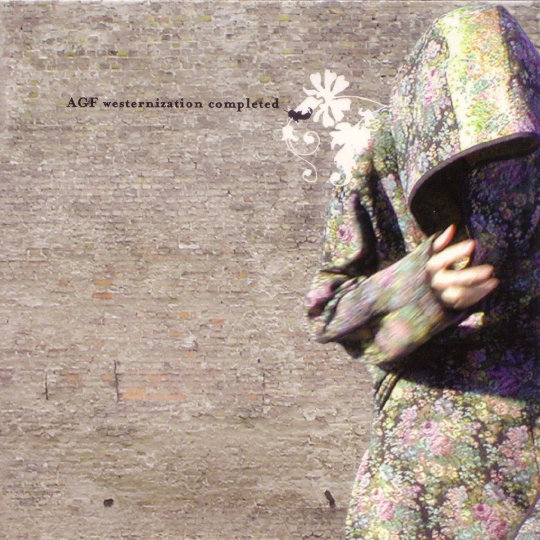
Ne bez razloga, osobna web stranica Antye Greie-Fuchs zove se poemproducer.com, iako ovu glazbenicu iz Berlina i čelnu osobu skupine Laub znamo najprije kao inicijal AGF. "Poezija" na koju se Antye referira nije međutim ona stara romatična vizija pjesnika u prirodi, zaokupljenog rimom i arhaičnim stilom, nego, kako ju ju ova digitalna poetesa sama naziva - "leftovers of poetry". Prvijenac "Head Slash Bauch" bio je vrlo zapažena transkripcija računalnih HTML skripti u govorni tekst, no često mu se u definirajuću odrednicu uzimala nekomunikativnost, tipična za eksperimentalnu scenu. Ovo, dakako, nije istom i oznaka kvalitete, jer nova AGF, naslovljena "Westernization Completed", nastavlja pretežuću pripadnost nežanrovskom poigravanju zvukom, samo što je cjelina sada bitno pristupačnija, čak i u kategorijama dnevnosvirajućeg radio mainstreama.
"Ostaci poezije", kako Antye voli reći, zapravo su reciklirane riječi razmještene u proizvoljne, ali ipak smislene tekstualne apstrakcije, i na ovome su drugom solo albumu prvi puta izvedene na engleskom jeziku. Izgovor i sintaksa dio su "broken english" kategorije - sasvim prikladno za glazbenicu koja je odrasla u nekadašnjem istočnom dijelu grada, a koja sada konceptualno evocira utjecaj Zapada na kulturološke trenutke vlastitog odrastanja. Ton albuma "Westernization Completed" intiman je i introspektivan, poput osobnog toka svijesti koji ne mari za gramatička, izgovorna, ali i glazbena pravila. Baš kao i "slomljeni" jezik, i zvučne, ritmičke strukture AGF spotiču se, mucaju i slamaju kao "broken beat", melodije bivaju naznačene u fragmentima, a bogati arhiv nađenih zvukova uključit će, prikladno, i ambijente kineskih restorana, gradske vreve i svega ostalog što civilizacija nosi.
Iz naslova i tematskog spoja dalo bi se pretpostaviti kako Antye Zapadu možda i zamjera upijanje Istočnog Berlina u svoj kulturni krug, no 12 kompozicija na "Westernization Completed" nemaju općedruštveni kritički šiljak, niti ikoga prozivaju za učinjeno. AGF se više zaokuplja vlastitim, ponajprije filmskim motivima grada, te u temi koja otvara album poziva na "let's make it more dramatic, like movies". Unatoč eksperimentalnome korijenu, ovaj album uspijeva nad obiljem manipulacija glazbe i vokala uspostaviti kontinuiranu ugodu i emotivnost, te se čak mjestimice odvažiti i u pjevani format, kao protutežu dominirajućem govornom. Antye tada, u naslovima poput "you STOP" i "contemporary WESTERNIZED" zvuči kao Björk, dok je dio recenzenata naveo usporedbu i sa prepoznatljivom bojom glasa Isabelle Rosselini.
Oprema albuma također navodi na daljnje utjecaje: raskošni dizajn prilično je inspiriran Peterom Greenawayem i njegovim filmom "The Pillow Book", pa Antye na sebi slika i ispisuje riječi, odnosno, doživljava i svoje tijelo "kao knjigu". "Westernization Completed" doista i jest impresivna knjiga zvukova i riječi, u svome intimizmu hrabro se odriče pretencioznosti, ali zato s gotovo dječjom iskrenošću zadržava izvorni, skoro pa naivni "art". "Westernizacija" je, nema dvojbe, završena, no na sreću, AGF nije asimilirana.
Željko Luketić
(emitirano 15.03.2004., Radio 101, emisija Antena)
0 notes
Photo
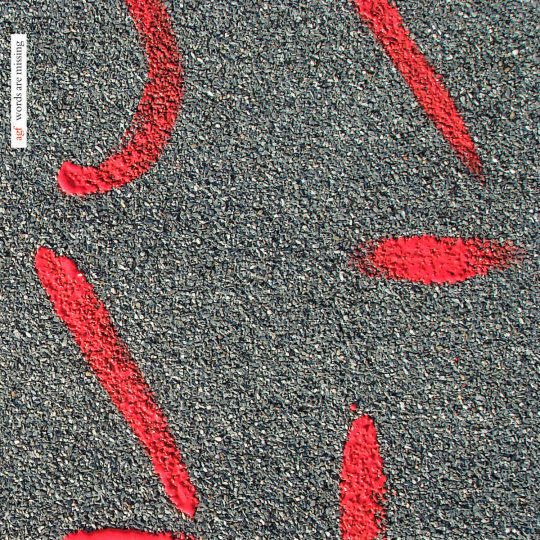
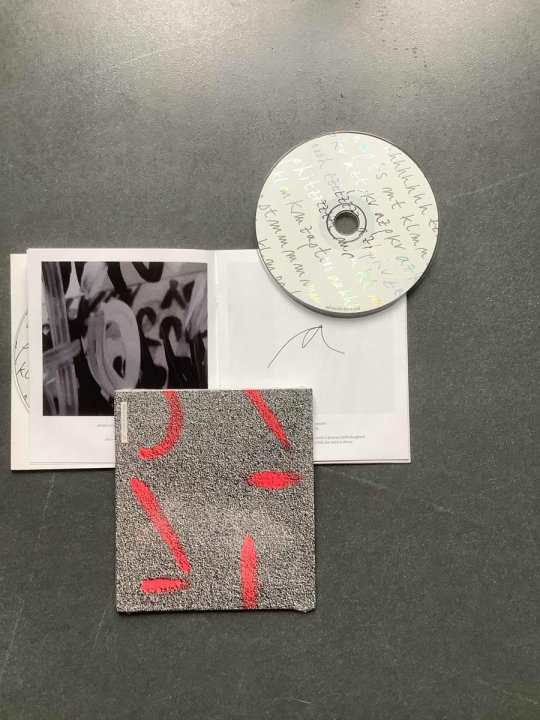
AGF, Words Are Missing, AGF Producktion, 2008. All songs writtem, performed and produced by AGF, all images by AGF, additional design by alorenz
#graphic design#art#music#music album#visual writing#handwriting#cd#cover#agf#poemproducer#antye greie#antye greie ripatti#agf producktion#alorenz#2000s
32 notes
·
View notes
Photo

Antye Greie-Ripatti (AGF), Germany
http://antyegreie.com
#agf#antye greie#antye greie-ripatti#music#musique#electro#electronic music#musique électronique#voice#voix#πwcm7
1 note
·
View note
Text
(SPAM Cuts) KICKING THE KAOS PAD - ENTERING INTO THE TECHNO-CHEMICAL DISORDER OF AGF-POEMPRODUCER

This week’s SPAM Cut features Max Parnell, looking at the transhumanist intimacies and techno aesthetics of self-proclaimed bass poetess, AFG Poemproducer’s new printed printed collection, Poemproducer, available now via paranoia publishing.
writing in the electronic age. if emotions have cycles. some salmiakki pattern. i am gathering thoughts from every corner of this electronic planet.
> Antye Greie, stage name AFG Poemproducer, is an e-poetess, writer, curator, musician and performance artist known for her deconstruction of language through digital technology. Off the page, she converts her poetry into electronic music, digital media and sound installations in auditoriums, museums and theatres.
> Her first printed collection Poemproducer, published by paranoia publishing group ltd., includes 30 of her poems selected from her poem-newsletter, each one being randomly translated into one of five languages.
> Throughout these poems, there's a sort of anxiousness that permeates the chopped up, fragmented sentence structure, mirroring the glitchy, jolting style of AGF's music that wavers between rhythmic and arrhythmic. As readers, we're frequently fed assertions that dart at us as if from paranoid eyes;
terrorists can attack / security tends to be reactive
terrorism is gang war / personal war / trapped
> It seems almost necessary to read these poems at a fast tempo, whereby we experience these warning words like flashes of a strobe light. Yet this anxious tone isn't consistently one of paranoia. On the contrary, the texts can be anxiously playful in their examination of what writing actually consists of:
I am enjoying the dance / authorship is not a feeling / it is work / revealing patterns / rhythms of people / the visible and audible / text is live / collected in / real time rooms / the ebb and flow of soundscapes
These examinatory passages crop up throughout the collection, often in the form of existential questions planted amongst the technological stream-of-consciousness flow. There's a sense of falling with each poem, of careering down the page, stumbling on every short burst of words that run into the next assertion. The narrative voice, often wavering between machine-like and personal, frequently addresses the reader, questioning 'what are we doing? / do we mean what we are / and are what we mean?' These unanswered questions work to help us make sense of the chaotic, obfuscating language breakdowns that characterise this collection.
> Perhaps the opening of 18, 'Subject: no harm can fall', most neatly encapsulates what it is like to read this collection:
you are now / entering the body of words / electrical dadada
strict codes cracked by / bending borders --->
It is here we enter this 'fragile state', one in which the borders between human and machine start to cross over, echoing the transhumanist rhetoric of 'human but perfected', articulated in the prosthetic metaphor of 'the body: a space-helicopter'. Poem 22 illustrates this flirtation with the cyborg, asking us 'isn't breathing techno? / are we just recreating heartbeat? / looking for extended battery life?' As transhumanists look to loosen the borders between homo sapiens and technology, Poemproducer's overtly technological style bends the boundaries between automated speech and narrative voice. Throughout the collection, there's a sense of being intimately addressed, of being present in the poems with the author. Yet the playfulness comes in the subtle AI shades that permeate the speaker's tone, presenting AGF's notion of language as coding, as seen in 'Subject:mmmmmmmm', a poem consisting of single letters, symbols and numbers.
> Nowhere does this merging of voice stand out more than in the small personal-yet-not-personal closing remarks that end almost every poem in the collection. These vary from the formal, 'with respect / yours AGF', to the warming 'with love from the woods / yours poetess' and even personal 'my dearest, i wish you an upmost powerful 2010!' The tone of the closing remarks fluctuates between impersonal computer automation and intimate speaker-listener interaction, perhaps an accurate way to describe the collection as a whole.
~
Text: Max Parnell
#Max Parnell#SPAM Cuts#Poemproducer#technology#poetry#technopoems#AGF#transhumanism#posthumanism#intimacy#cyborg#automation#Antye Greie
1 note
·
View note
Video
youtube
"Numb" - Jenna Valenzuela, Club Dance Studio, teen contemporary solo, 4th overall, Jump Portland OR, March 2017
★ Choreography by Chelsea Jennings
♪ PRIVATEbirds ~ Antye Greie
♪ Greim93 ~ Antye Greie
17 notes
·
View notes
Photo
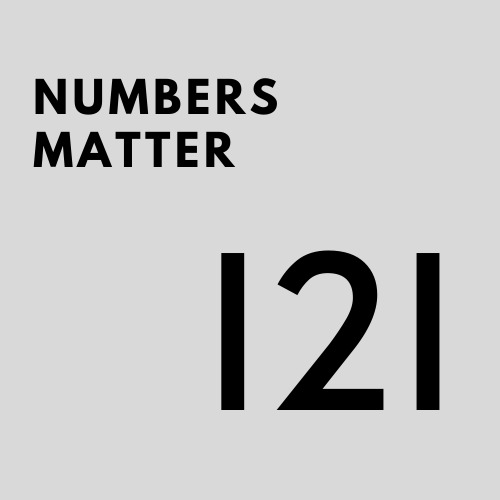
NUMBERS MATTER 121
チハルMK 、 おたこ、 川畑優、 AGF、 日野繭子、 大西蘭子
Thursday 22 October – 9pm (UK time) | Free
IKLECTIK YouTube Channel: https://youtu.be/HXFmH46kVEQ
Why numbers matter: Japan, a country with a population of over 124.2 million, is ranked at 121 in the Gender Inequality Index (GII) published by Human Development Reports 2020. Japanese women got the vote in 1946 – earlier than China (1949), Liechtenstein (1984) and Switzerland (1993).
In the ranking chart of the Global Gender Gap 2020, the top ten reads as follows: 1: Iceland; 2: Norway; 3: Finland; 4: Sweden; 5: Nicaragua; 6: New Zealand; 7: Ireland; 8: Spain; 9: Rwanda; 10: Germany. The UK ranked 21, following Albania at number 20. Though Japan falls some 100 places behind the UK, the latter’s ranking at 21 is nothing to be proud of either. Clearly there is plenty of work to be done in both countries. Hence, NUMBERS MATTER 121 features four special projects led by Japanese women: Chiharu MK, Otaco, Yu Kawabata (in collaboration with German poemproducer AGF) and Mayuko Hino.
Footnote: In the Press Freedom Index published in 2020, Japan and the UK don’t fare much better than in the GII. Out of 180 countries listed, the UK is ranked at 33 and Japan at 66. The countries listed from one to ten are as follows: Norway, Finland, Denmark, the Netherlands, Jamaica, Costa Rica, Switzerland, New Zealand, Portugal and Germany.
Programme:
“Paramnesia 2020” by CHIHARU MK
“Tomodachi” by OTACO
“Hamaderea Park ” by YU KAWABATA (sound) + AGF (visuals)
“Toyosu 2020″ by MAYUKO HINO

Chiharu MK is from Sapporo. Primarily trained as a composer, she studied the acousmonium, that is, the sound diffusion system, at INA-GRM studio in Paris. Since completing her studies in 2002, she has become an internationally recognised electroacoustic sound artist, either performing or creating sound installations for festival, gallery or non-concert hall spaces in Europe, Hong Kong and Japan. For Intersect 2015, she commissioned the non-Japanese artists Francisco López, Sogar and Taylor Deupree to compose sounds for a 17.1 multi Channel Speaker System (consisting of seven speakers + ten screen speakers + one woofer) in Sapporo city centre’s underground walkway. Chiharu MK has also released three solo CDs: https://www.studio-cplus.net/
Chiharu MK’s new multimedia work Paramnesia 2020 is based on her original piece for Hong Kong Art Centre’s 40th anniversary multi-channel Sound Forms festival in 2018.
This film shows her performing the piece inside Glass Pyramid, nicknamed Hidamari – Japanese for Sunny Spot, it’s the centrepiece of Sapporo’s Moerenuma Park, designed by Japanese American sculptor Isamu Noguchi (1904–1988). Construction work on the park actually began in the year Noguchi died, and it opened in 2005. The film also shows Chiharu MK recording on Ishikari beach, just north of Sapporo.
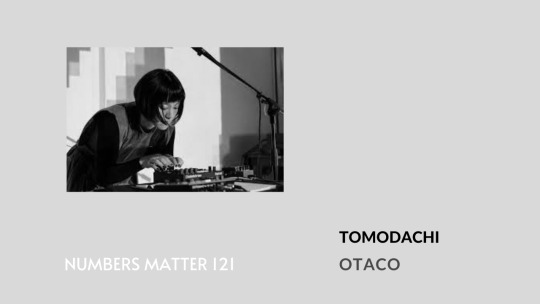
Taking her name from tako, the Japanese word for octopus, Otaco is originally from Japan’s northernmost main island Hokkaido. An electronic musician and vocalist, Otaco is one of the most vibrant and engaging performers to emerge from the alternative music scene anywhere in Japan.
Now living in Tokyo, she operates a home studio set-up of a rhythm box with a synthesizer; she samples and syncs sounds into a computer, running them into real-time sequences to construct her outre pop-electronica songs and instrumentals. Her music can be heard at https://otacosan.bandcamp.com/music. Otaco also plays guitar when she leads Gotou, an occasional rock trio formed out of homage to early 1980s West Berlin groups Mania D and Malaria!. She appeared for the first time in the UK during Coding In GE 2018 festival for women and technology.

Antye Greie also know as AGF was born and raised in East Germany. She is a vocalist, digital songwriter, producer, performer, e-poet, calligrapher, digital media artist. In the last decade Greie has released more than 20 full length records and played over 300 live performances worldwide.
AGF runs her own production company AGF Production – http://antyegreie.com
She first worked with Yu Kawabata on her 2015 album A Deep Mysterious Tone, the third in AGF’s series of settings and poetry interpretations from different countries, this one featuring Japanese poets and writers including Noe Ito, Fumiko Kaneko, Shikubu Izumi, Blue Stocking editor and writer Hiratsuka Raicho, and more.
Yu Kawabata is a techno DJ active in Japan and Russia. This is Yu and AGF’s second collaboration. On their first, AGF set to music Yu’s reading of a waka poem, written by the 12th century court lady Yūshi Naishinnō-ke no Kii, enumerated as one of the Thirty-Six Female Immortals of Poetry. On their latest, Yu has created new music for a film by AGF.
https://soundcloud.com/yukawabata
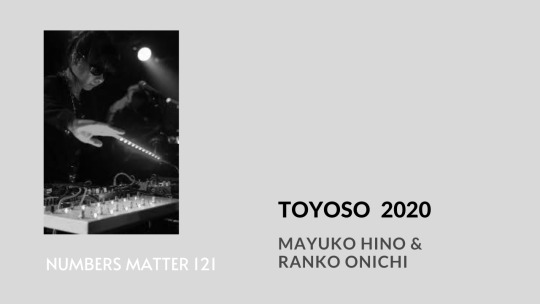
Since resuming music in 2011 after a ten year break to study Chinese medicine, Mayuko Hino has reclaimed her status as queen of noise.
A prolific live performer, Hino is best known for C.C.C.C. (Cosmic Coincidence Control Center), the group she formed in 1990 with Hiroshi Hasegawa, Fumio Kosakai and Ryuichi Nagakubo. In their early phase, the band grabbed attention by combining noise music with Hino’s sadomasochism performances using bondage ropes and dripping candle wax. Hino has since been a member of Mne-Mic, DFH-M3 and her most recent group Transparentz with Akira Sakata, who split up in January 2020.
Whether solo or in her various group projects, Hino experiments with the function of noise music as a transdisciplinary medium, in the process to breaking the boundaries surrounding performance art: urban structure against man, art against non art, activity versus rest.
In 2018 Mayuko Hino performed at Iklectic’s Coding In GE Festival alongside and in collaboration with Ramleh. The same year she released her second solo album Lunisolar. In addition to self-made instruments, Hino plays noise with her six-theremin oscillators (in bright pink), a unique device specially made for her by Ryo Araishi (aka ichion)
This year Hino had planned to resume activities with C.C.C.C. to mark the US reissue of their first four albums, but unfortunately their plans had to be put on hold because of the pandemic.
“There’s a sense of momentum to be found in Hino’s noise; it’s rarely static… At the hands of Hino it seems astral travelling is as much out-of-this-world as it is an out-of-body experience… on Lunisolar she continues with the ever evolving atmospheric and psychedelic sound that energised the noise of C.C.C.C.” (Compulsion Online)
“Hino Mayuko makes no bones about her wide-ranging noisician flexibility here, nor her honored place in the contemporary Japanoise scene… Unlike a bevy of artists who just make ear-splitting sonic somersaults, Hino’s sound is more impressionistic and staggered in its delivery, incorporating a yin/yang of the industrial and environmental.” (Tone-Shift)
RANKO ONISHI (Mne-mic): voice
Performing artist Ranko Onishi was born in Hokkaido. She moved to Tokyo where she joined Shuji Terayama’s Tenjo Sajiki theatre company in 1980. She was a second year student of dancer Min Tanaka in 1982 and became a full member of Tanaka’s company in 1984. Five years later in 1989 she performed with Keiji Haino. She and Hino work together in the duo Mne-mic, featuring Hino on electronics, Theremin and synthesizer, and Onishi on voice, water and fogphone. Their album Gulf Stream was released by Alchemy Records in 1999.
Curator Keiko Yoshida’s notes for NUMBERS MATTER 121
While researching texts for AGF’s 2015 CD A Deep Mysterious Tone I developed a profound interest in women’s history in Japan. AGF and I first met and begain talking about her project while she was taking part in my hometown Sapporo’s International Arts Festival in 2014. For the album she compiled and set to music Japanese writings and poems from the ninth century to the present day, and commissioned the female electronic musicians Ryoko Akama (UK), Kyoka (Germany), Tujiko Noriko (France) and Yu Kawabata to read her selections. She had met them at European festivals, and as she got to know them she learnt these female electronic musicians are not treated very well when they’re back home in Japan.
Indeed NUMBERS MATTER 121 took seed in these discussions on women and Japan with AGF. In some ways it’s also a sequel to “Coding in GE”, the 2018 Iklectik festival offering a platform to female electronic musicians, for which we got funding from Sasakawa Foundation UK, and in which Otaco, Mayuko Hino and AGF participated.
Another question addressed in NUMBERS MATTER 121 is the subject of decentralisation. I consciously asked musicians from outside Tokyo to participate in this project.
Currently working on a photo story book about 1980s London and Berlin.
Please support the project buying an e-ticket (#nameyourprice).
** https://buytickets.at/iklectik/439711 **
2 notes
·
View notes
Quote
a strange, sensitive interaction between electroacoustic methodology and stylistic references to bass music and breaks. The energy of this experimental hybridity captures contemporary trends and issues in areas such as sociopolitics, geopolitics, agency and ontology; AGF subjects quite a range of topics to aesthetic and metaphorical exploration.
https://irregularcrates.com/2017/11/19/agf-solidicity/
2 notes
·
View notes